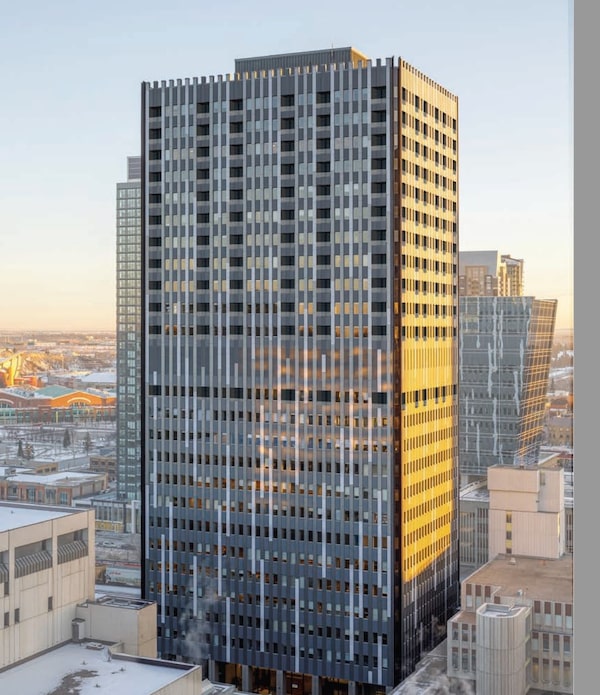Three developers in Calgary have been given the green light to transform lifeless downtown office buildings into rental housing, as the city attempts to lower its country-leading office-vacancy rate and revitalize the often desolate core.
The City of Calgary on Wednesday announced the first three projects approved through its Downtown Calgary Development Incentive Program. Altogether they will remove 414,000 square feet from the market and create 401 residential units.
About $31-million of the program’s $100-million fund will be divvied up between the successful applicants – Aspen Properties, Cidex Group of Companies and Peoplefirst Development – upon project completion, based on the number of living spaces created.

Peoplefirst Development's proposed project for downtown Calgary.City of Calgary
About one-third of Calgary’s downtown office space currently sits empty, fuelled by a volatile oil and gas industry and compounded by the COVID-19 pandemic. Roughly 14 million square feet is unoccupied, primarily in the central core, according to a first quarter report by commercial real-estate company CBRE.
While the downtown core has long been considered a concrete ghost town, which has worsened since oil prices collapsed in 2014 and triggered a recession, there have been recent signs of improvement as high oil and gas prices drive a recovery. CBRE says 63,000 square feet of space was absorbed in the first quarter of this year, dropping the vacancy rate marginally to 32.8 from 33.2 in the previous quarter. Other agencies have similarly reported that the vacancy situation in downtown Calgary is levelling off.
Mayor Jyoti Gondek said Wednesday an estimated six million square feet of office space needs to be removed from the market by residential conversion, alternate uses or demolition to stabilize downtown property values over the next decade. “Today is part of the first steps on that road towards this important goal,” Ms. Gondek said. “This conversion initiative supports downtown’s economic recovery by expediting the elimination of unused office space downtown and the development of downtown residential neighbourhoods – a plan that will allow people and businesses to prosper.”


The Aspen Properties and Cidex Group of Companies projects.City of Calgary
On the east side of downtown, the Palliser One project will be the largest of the three ventures. Aspen Properties is set to transform the 27-storey, B-class office near the Calgary Tower into a mix of one- and two-bedroom apartments. Nearby, Cidex Group of Companies will revamp an 11-storey C-class building into rentals with a focus on creating a vibrant community space.
Rob Blackwell, Aspen’s chief operating officer, said he believes they will spend 25 per cent less by repurposing the office building than by starting from the ground up, largely because of its depreciated market value. Mr. Blackwell also said it is an environmentally-conscious undertaking. “The most environmentally friendly residential building is one that isn’t built at all. With virtually zero concrete being used in this new project, the conversion of Palliser One will save 500 million tonnes of greenhouse gases from being produced,” he said.
The third project, on the west end of downtown, will bring new life to a 10-storey B-class building that has sat vacant for nearly a decade. Peoplefirst Developments plans to build apartments across eight floors with a commitment to put 40 per cent of the units 20 per cent below market value.
Eight other project applications are under review by the city.
Greg Kwong, vice-president and regional managing director for CBRE, said office-to-residential conversion projects are a “drop in the bucket in the grand scheme of things” but can help to alleviate some strain on Calgary’s bludgeoned downtown.
“It’s one of the many levers that we have to pull,” Mr. Kwong said. “I would suggest that most, if not all, of the applications would have to be accepted in order for it to make a dent in the in the high amount of vacant [spaces] that we have.”
The office-vacancy rate has become a barometer for Calgary’s battered economy and directly correlates with building values and property taxes. Just last year, non-residential assessments downtown dropped by $801-million, or roughly 8 per cent, compared with 2020. Alberta’s unemployment rate is among the highest in Canada, but numbers have been improving.
“We stopped the free fall from going deeper into higher vacancy, but by no means have we got rid of high vacancy … there’s still a long way to go.”
:format(webp)/cloudfront-us-east-1.images.arcpublishing.com/tgam/RHQ6IPBTKNB4BCGUQTX5IQGH7U.jpg) The void in Calgary: A Globe investigation
The void in Calgary: A Globe investigation
Even before the COVID-19 pandemic, Calgary had the highest rate of commercial vacancies in Canada as falling oil prices and economic downturns hollowed out the downtown core. Jeremy Agius and James Keller take a visual tour of how it happened and what the city might do next.
We have a weekly Western Canada newsletter written by our B.C. and Alberta bureau chiefs, providing a comprehensive package of the news you need to know about the region and its place in the issues facing Canada. Sign up today.
 Alanna Smith
Alanna Smith